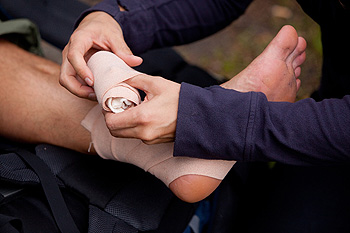Call Us Today! (203) 975-9600
SAME DAY APPOINTMENTS AVAILABLE
April 2023
Methods to Improve Ankle Stability

For anyone who has sprained an ankle, the necessity for strengthening the joint after healing is important. A weakened ankle joint increases the risk of another sprain, which can evolve into chronic ankle instability. A symptom of an unstable ankle is the feeling that the joint gives way during normal activity, which is often a sign of an overstretched ligament. Treatment options include performing a series of neuromuscular exercises to strengthen the ankle joint, along with wearing a protective brace for stability. If the ligament is still too loose, surgery becomes an option. The ligaments, which hold the joint in place, can be shortened and tightened, or in some cases, replaced. Ankle instability can also cause problems with muscle coordination, and for this reason strengthening exercises may be helpful. If you have experienced a recurring ankle stability problem, it is suggested that you consult a podiatrist for a full examination of the joint and the right treatment options for you.
Ankle sprains are common but need immediate attention. If you need your feet checked, contact one of our podiatrists from Preferred Footcare, LLC. Our doctors can provide the care you need to keep you pain-free and on your feet.
How Does an Ankle Sprain Occur?
Ankle sprains take place when the ligaments in your ankle are torn or stretched beyond their limits. There are multiple ways that the ankle can become injured, including twisting or rolling over onto your ankle, putting undue stress on it, or causing trauma to the ankle itself.
What Are the Symptoms?
- Mild to moderate bruising
- Limited mobility
- Swelling
- Discoloration of the skin (depending on severity)
Preventing a Sprain
- Wearing appropriate shoes for the occasion
- Stretching before exercises and sports
- Knowing your limits
Treatment of a Sprain
Treatment of a sprain depends on the severity. Many times, people are told to rest and remain off their feet completely, while others are given an air cast. If the sprain is very severe, surgery may be required.
If you have suffered an ankle sprain previously, you may want to consider additional support such as a brace and regular exercises to strengthen the ankle.
If you have any questions please feel free to contact our office located in Stamford, CT . We offer the newest diagnostic and treatment technologies for all your foot and ankle needs.
A Podiatrist’s Credentials

If you are currently suffering from some kind of affliction of the foot, seeing a podiatrist might be a good way to receive medical attention for what is impairing your health. There are several reasons why podiatrists are highly qualified medical professionals. First, podiatrists must pass a series of exams. They must also obtain official certification from the American Board of Podiatric Medicine. Before beginning their practice, a podiatrist must also undergo a rigorous education in podiatric medical school. A podiatrist also gains valuable experience by working in a residency. Podiatrists are trusted medical professionals, and it is suggested that you schedule an appointment with one today to address any issues you might be having with your feet.
If you are experiencing pain in the feet or ankles, don’t join the stubborn majority refusing treatment. Feel free to contact one of our podiatrists from Preferred Footcare, LLC. Our doctors can provide the care you need to keep you pain-free and on your feet.
What Is a Podiatrist?
Someone would seek the care of a podiatrist if they have suffered a foot injury or have common foot ailments such as heal spurs, bunions, arch problems, deformities, ingrown toenails, corns, foot and ankle problems, etc.
Podiatric Treatment
A podiatrist will treat the problematic areas of the feet, ankle or lower leg by prescribing the following:
- Physical therapy
- Drugs
- Orthotic inserts or soles
- Surgery on lower extremity fractures
A common podiatric procedure a podiatrist will use is a scanner or force plate which will allow the podiatrist to know the designs of orthotics. Patients are then told to follow a series of tasks to complete the treatment. The computer will scan the foot a see which areas show weight distribution and pressure points. The podiatrist will read the analysis and then determine which treatment plans are available.
If you have any questions please feel free to contact our office located in Stamford, CT . We offer the newest diagnostic and treatment technologies for all your foot and ankle needs.
Wounds That Don't Heal Need to Be Checked
Dealing With Your Child’s Gait Disorder

The gait, which is the way we walk, starts to develop as soon as a child stands up. As they age children go through different stages of gait development, and it is a good idea for parents to monitor these patterns and take note of abnormalities. Three recognizable gait disorders in children are in-toeing, out-toeing, and toe-walking. While in-toeing, also termed pigeon toe, is typical in many children under the age of 3, it also can be caused by a condition where the front of the foot curves inward instead of remaining straight. This can result in a child falling more often than normal. Out-toeing refers to walking with the toes pointed outward instead of straight ahead. It can be the result of flat feet, lower leg misalignment, or hip joint abnormalities. Toe walking is just what it sounds like the child walks on its toes. This can produce tight or shortened calf muscles and may affect balance and cause muscle soreness. If your child displays these or other gait abnormalities, it is suggested that you make an appointment with a podiatrist who can assess the situation and provide guidance on how to handle it.
The health of a child’s feet is vital to their overall well-being. If you have any questions regarding foot health, contact one of our podiatrists of Preferred Footcare, LLC. Our doctors can provide the care you need to keep you pain-free and on your feet.
Tips for Keeping Children's Feet Healthy
- Make sure their shoes fit properly
- Look for any signs of in-toeing or out-toeing
- Check to see if they have Clubfoot (condition that affects your child’s foot and ankle, twisting the heel and toes inward) which is one of the most common nonmajor birth defects.
- Lightly cover your baby’s feet (Tight covers may keep your baby from moving their feet freely, and could prevent normal development)
- Allow your toddler to go shoeless (Shoes can be restricting for a young child’s foot)
- Cut toenails straight across to avoid ingrown toenails
- Keep your child’s foot clean and dry
- Cover cuts and scrapes. Wash any scratches with soap and water and cover them with a bandage until they’ve healed.
If you have any questions, please feel free to contact our office located in Stamford, CT . We offer the newest diagnostic and treatment technologies for all your foot care needs.
Types of Arthritis That Can Affect Your Feet

Arthritis is an inflammatory disease that attacks the joints and can cause pain, stiffness, swelling, and bone deformities. There is no known cure for arthritis, but there are many ways of treating the symptoms that allow patients to lead active lives. Because the feet contain 33 joints each, arthritis can negatively impact your daily life, even simply the ability to walk. The main types of arthritis that cause foot problems are osteoarthritis, rheumatoid arthritis, post-traumatic arthritis, and gout. Osteoarthritis is a degenerative disease that erodes the cartilage between the bones of the joint. This causes very painful inflammation and is most common among people 50 and older. It is known as wear and tear disease. Rheumatoid arthritis is a crippling disease where the immune system attacks the body’s cartilage, resulting in deformities. Post-traumatic arthritis can develop after sustaining an injury to the foot or ankle. Gout, which frequently attacks the big toe, is caused by having abnormal amounts of uric acid in the system. To find out more about how arthritis may be causing your foot pain, it is suggested that you consult a podiatrist.
Arthritis can be a difficult condition to live with. If you are seeking treatment, contact one of our podiatrists from Preferred Footcare, LLC. Our doctors can provide the care you need to keep you pain-free and on your feet.
Arthritic Foot Care
Arthritis is a term that is commonly used to describe joint pain. The condition itself can occur to anyone of any age, race, or gender, and there are over 100 types of it. Nevertheless, arthritis is more commonly found in women compared to men, and it is also more prevalent in those who are overweight. The causes of arthritis vary depending on which type of arthritis you have. Osteoarthritis for example, is often caused by injury, while rheumatoid arthritis is caused by a misdirected immune system.
Symptoms
- Swelling
- Pain
- Stiffness
- Decreased Range of Motion
Arthritic symptoms range in severity, and they may come and go. Some symptoms stay the same for several years but could potentially get worse with time. Severe cases of arthritis can prevent its sufferers from performing daily activities and make walking difficult.
Risk Factors
- Occupation – Occupations requiring repetitive knee movements have been linked to osteoarthritis
- Obesity – Excess weight can contribute to osteoarthritis development
- Infection – Microbial agents can infect the joints and trigger arthritis
- Joint Injuries – Damage to joints may lead to osteoarthritis
- Age – Risk increases with age
- Gender –Most types are more common in women
- Genetics – Arthritis can be hereditary
If you suspect your arthritis is affecting your feet, it is crucial that you see a podiatrist immediately. Your doctor will be able to address your specific case and help you decide which treatment method is best for you.
If you have any questions, please feel free to contact our office located in Stamford, CT . We offer the newest diagnostic and treatment technologies for all your foot care needs.









